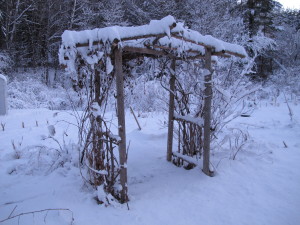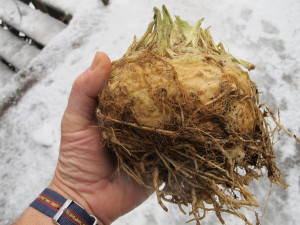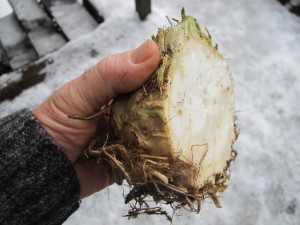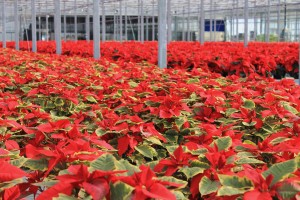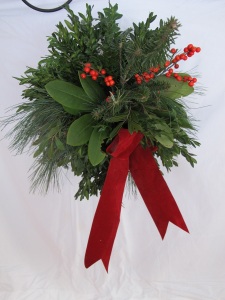One Gardener’s Plans for the New Year
Each year after the winter solstice I take some time to think about my garden of the past year and to make plans for the upcoming garden season. What worked? What didn’t? It’s good to think about such. I won’t say I’m making any gardening resolutions this year, but I’ll share with you my aspirations. But I won’t feel bad if I don’t accomplish exactly what I hope to do. Each year life has a way of getting in the way of best made plans.
The past year was a good one for me. In past years my vegetable garden has been getting shadier – trees have a way of getting bigger, and even relatively distant trees have been cutting down on the hours of sunshine in the garden. This past year I was lent a nice plot in full sun, a plot with good soil that belongs to a friend and that had been farmed organically. It was bigger than I needed, but a farmer agreed to till it and get it ready for planting. So my partner Cindy Heath and I planted all kinds of veggies including sweet corn and dry beans – crops I hadn’t had room for in past years. And we planted extra food to give away.
Our vegetables did well. There was sufficient rain and perhaps because the land had been fallow for a year or more, pests and disease problems were minimal. Even the potato bugs were few. We fenced off the beans (both dry and green, both loved by deer), and the raccoons didn’t do much damage to the corn. We had plenty for us, our friends, and the coons. (Maybe the coyote urine I put out in little Airwick containers helped keep the coons away).
So will I plant the “farmette” (as we called it) again this year? You betcha. It was a lot of work, but I really enjoyed having as much space as I wanted in full sun. I love having excess vegetables to share, and my little farmette allows me to do that.
My grandfather, John Lenat (1885-1967), had a regular vegetable route in his later years. He drove around his town (Spencer, Massachusetts) in his bright red Nash Rambler giving tomatoes, lettuce and cucumbers to his friends. He’d never accept a nickel for his produce. I remember being amused that he even brought tomatoes to give the checkout clerk at the A&P Grocery store. In those days there were no soup kitchens or homeless shelters, but there are now, and they are happy to accept what any of us can contribute.
This year I’ll also plant some flowers at the farmette. A dear friend gave me a gallon Ziploc bag of dried zinnia seed heads from her garden. She tills a patch of soil that is about 4 feet wide and 50 feet long each year just for zinnias. Big, tall, brightly colored zinnias. And each year she harvests enough seeds in the fall to plant it again – and to give away plenty, too. So I shall try the same.
I looked in my Johnny’s Selected Seeds catalog to see what zinnias might cost in bulk, for those of you who want to try a similar effort. A thousand seeds of the ‘Benary’s Giant Series’, costs $29.30, but the ‘Giant Dahlia Flowered Series’ costs just $12.15 for an ounce that has 3,200 seeds. Since I have never tried a mass planting like that before, I can’t advise you as to how many seeds you might need for a mass planting. I plan to scatter seeds on tilled soil, rake them in, and hope for the best.
Our farmette is about 6 miles from my house. I’ll plant most of our veggies for canning, freezing and dehydrating over there. But I’ll also continue to grow some veggies at my home garden, focusing on things that do well with less than full sun: lettuce, kale, herbs, leeks, carrots, and Brussels sprouts. I’ll also plant a few tomatoes and summer squash at my home garden for the convenience of being able to pick them for dinner.
This year I’ll try to slow down a little, too. By the time planting season comes I’ll be 69 years young. And although I’ve been gardening for others for a long time, I think I’ll try to minimize the time I spend in other people’s gardens this coming year. Become more of an advisor, and less of a digger, weeder and wheelbarrow pusher. I’ll try to focus on my own gardens, given that I have expanded them.
What else will I do in 2015? I’ll work hard at controlling the invasive plants that are always trying to get a foothold. Just cutting back purple loosestrife 3 times in the summer will do much to keep it from expanding its territory. And I’ll keep an eye out for garlic mustard, which so far has not made it on to my property, but is within a mile of my house.
The list could go on and on. Re-build the garden arbor that has started to fall apart. Dig out some of the biggest goldenrod that I (foolishly) have allowed to get too rambunctious. Try new kinds of flowers. Plant some early-season raspberries that will be done by the time that new kind of fruit fly arrives in late summer. And so on.
So take some time in your easy chair and make your own plans. And feel free to share them with me if you like, I’m always happy to get mail or e-mail. Maybe you’ll inspire me to try something new. My best to you all for 2015.
Contact Henry by e-mail at henry.homeyer@comcast.net or write the old fashioned way to P.O. Box 364, Cornish Flat, NH 03746. Please include a self-addressed stamped envelope if you have a question you want answered.
Eating from the Garden
Here it is, officially winter, and I’m still eating from my garden. I recently made what I call a winter salad: grated carrot and celery root (also known as celeriac) with a vinaigrette sauce. Sometimes my winter salad also gets grated or chopped apple, or some dried cherry tomatoes. Only the ingredients for dressing are bought – vinegar and oil – though I have been known to even make my own vinegar some years. Of course dried currants or raisins are also nice in that salad, but I don’t grow those. I could put in dried blueberries, as I do dry a few each year, but haven’t tried them in the salad yet.
Celeriac is an unsung hero. Most gardeners don’t grow it. Most gardeners should. It’s a root crop related to celery, has a similar flavor, and the leaves are nearly identical. Unlike most root crops, the bulk of this root sits up above the ground level. The meat of this vegetable has the consistency of a carrot, but it is white and round. Mine grow to be 3 to 6 inches in diameter.
Celeriac stores well and stays tasty for months. In the fall I cut off the tops, cut back most of the roots, and wash out the dirt from the thick mass of roots. Then it will store for 3 to 4 months in a cool place with high humidity. You could do this by putting the celeriac in a plastic bin or bucket and storing it a cool place that stays in the 33 to 50 degree range. To keep the humidity high you can put an inch of moist sand in the bottom of the bucket.
Another way to store celeriac, carrots, potatoes, kohlrabi and rutabagas is to get an old fridge. Often older model fridges are available free from on-line list serves – or even in your daily newspaper. That’s how I got a 1946 GE model that still works fine, and it does not have the undesirable “frost free” feature. Modern refrigerators remove the humidity from all but the vegetable drawers. But many older ones do not, and thus are great for filling up with storage vegetables. Or, one can store veggies in modern fridges in plastic bags that have been punched with many holes using a paper punch.
Unfortunately, many garden centers do not sell celeriac seedlings in the spring. So if you want to grow celeriac, you may want to order seeds this winter when you put together you seed order. I start them indoors, starting in early- to mid- March. They are a bit slow to germinate, and need consistent moisture from planting to harvest. They don’t like cold weather or soil in the spring, so I transplant them into the ground in June.
Celeriac needs soil that doesn’t dry out. Sandy soils do not hold moisture well, while heavier, clay-based soils do. If you have a light, sandy soil, do not grow celeriac in raised beds, as raised beds tend to drain off and dry out more quickly. And add lots of compost to the soil before planting, as compost tends to act a bit like a sponge, holding water.
In addition to using celeriac in my winter salad, I use celeriac in stir fries, soups and stews. It adds a celery flavor – and a richness – that I like. And I haven’t had much luck growing celery. When I’ve tried in the past, I had trouble with slugs, the stems have been spindly, and celery in general does not store as well as celeriac.
My friend Ed Smith of Cabot, Vermont, is the author of a number of excellent gardening books, including The Vegetable Gardener’s Container Bible. I called him recently to see how he grows celery, as I recalled that he does well with it. He told me that new no longer grows celery in the ground. He only grows it in self-watering containers.
Ed told me that he gets containers from Gardeners Supply (www.gardeners.com) that are roughly 3-feet square and 12 inches deep. At the bottom of each container is a reservoir that holds a couple of inches of water separated from the soil mix by a plastic barrier; it has a wicking system that keeps the soil consistently moist, but not soggy. In his big container he plants 18 to 20 plants, and puts it in full sun.
For a soil mix Ed uses a 50-50 mix of compost and peat moss, and he adds a cup of organic fertilizer and usually some Azomite. Azomite is a rock powder sold in 50-lb bags that has trace minerals not found in fertilizers.
The key to success with celery, according to Ed, is to keep it consistently moist and pick it small. Don’t wait until your celery looks like the stuff from the grocery store, pick it when the stalks are small, say half an inch in diameter. He doesn’t usually start his own plants as they take a long time to grow, but buys plants from a greenhouse. Ed told me that he chops up his celery and freezes it in pint zipper bags. Then he uses is all year in soups and stews. He does not blanch it before freezing.
It is winter now, but not too early to start planning your garden for 2015. Read the seed catalogs, dream, and before you know it, it will be time to start next year’s seedlings.
Henry Homeyer is the author of 4 gardening books. His web site is www.Gardening-Guy.com.
Poinsettias
I like poinsettias and buy one every year. And every year the poinsettia industry produces new colors and shapes for the “flowers”. Standard red has given way to pink, maroon, white and red, pink and red; simple bracts are now double, double with ruffles. There is always a call for the new and different. Me? I’m a simple gardening guy who likes the simple old fashioned kind.
Botanically speaking, those red parts of a poinsettia are actually called bracts. The flowers are the tiny yellow center of each “flower”, and the red bracts are leaves purely for decoration – and an advertisement to any stray pollinator (or shopper) that might be around.
Poinsettias are native to Mexico, and were first introduced to the United States in 1828 by President Andrew Jackson’s ambassador to Mexico, Joel Poinsett. But they have traveled the world. When I was working in Bamako, Mali, West Africa, in the early 1980’s, I had hedges of poinsettias that were five feet tall. But it took a long time for poinsettias to become popular.
In 1923 a grower named Paul Ecke started growing them in quantity in California, selling plants wholesale and shipping them by rail all over the country. He worked on growing good, durable plants that he sent to growers so that they could start cuttings and make more plants. He was a trained horticulturist, but also a good marketer. He gave free plants to TV hosts like Johnny Carson and Bob Hope for his Christmas Special every year. Through the magic of TV he got Americans to associate the idea of Christmas with poinsettias.
One reason that poinsettias are so popular is that they are easy to keep looking nice – even those folks with “brown thumbs” can keep them going for a couple of weeks or more. They are almost like plastic plants. And most of us feel no guilt about throwing them out when they start to look ratty.
If you’ve never offered a home to a poinsettia, here’s what you need to do: Water it once a week, give it some indirect light, and avoid placing it in a cold or drafty place. Temperatures of 68 to 72 are recommended, but my house is rarely that warm, and they do fine for me. And don’t put it on top of a radiator or anywhere where it will get too hot and dry out too quickly.
The worst thing you can do for a poinsettia is to overwater it. Too much water will rot the roots, and your holiday plant will go into a decline and die. I lift the pot and can tell by its weight whether it needs water or not. But you can stick your finger in the soil, too. If it is wrapped in foil, make a hole in the bottom so that excess water can drain into the saucer.
Getting poinsettias to bloom in their second year is complicated, and not worth the effort for most of us. One must give them bright light during the day, and no light at all for 12 hours or more – which means moving them into a closet or basement, and remembering not to turn on the light. I have read figures citing 5 days of dark treatment as adequate, but also up to 10 weeks of dark from 5pm to 8am. Who knows? I once read read that a big grower had trouble getting his plants to develop their red leaves simply because he had a night watchman who liked plants and shined his flashlight around the greenhouse on his nightly rounds.
My mother, may she rest in peace, never had poinsettias because she believed, mistakenly, that they were poisonous. She feared that her cat would eat a leaf and die. I told her that was not the case, but she was a worrier, and wouldn’t take a chance with her dear cat, Bella (may she, too, rest in peace).
Ohio State University in cooperation with the Society of American Florists did a study that proved that poinsettias are not the threat my mom believed they were. Yes, they are in the genus Euphorbia, a group of plants that have alkaloids in their white sap. But the sap is not very toxic. According to the Mayo Clinic web site, poinsettias are not good to eat, and might cause a tummy ache or a rash, but unless you are allergic to them, nothing serious is likely to happen if you make them part of your lunch. Or your cat’s lunch.
From a Darwinian point of view, it might make sense for a plant to make itself poisonous, or at least unpleasant to eat. After all, plants want to reach maturity and produce seeds, allowing their genetic material to be passed on to the next generation. They don’t want all their leaves to be eaten before maturity. But the bottom line is, feed your cat well, and she probably won’t even get a tummy ache from nibbling your poinsettia.
So get yourself a poinsettia. They will provide some nice color on your table for the holidays. Just don’t water it too much.
Henry Homeyer is the author of 4 gardening books. His Web site is www.Gardening-Guy.com.
Kissing Balls
At this time of year I need all the help I can get. Cloudy gray days do not make me cheerful. Days that end at 4pm do not please me. I counteract the dark with lights, flowers on the table, greenery (and maybe a little chocolate). This year I decided to make a kissing ball to hang from my chandelier in the living/dining area.
Kissing balls have a long history. During the Middle Ages villagers would hang balls of evergreens with a clay figure representing the Baby Jesus inside. Later, during the Victorian era, people would poke greens, particularly sweet-smelling greens, into apples or a potatoes and them and hang them in the house.
But they fell into disfavor, and mistletoe remained as the primary green hung in the house during much of the 1900’s. Mistletoe, of course allowed high-spirited youth to steal a kiss if a maiden was “accidentally” standing under the mistletoe. In this day of lawyers, no one wants to sell mistletoe because the berries are quite poisonous. But now decorated evergreen balls are back, being sold as kissing balls. I recently made one.
When I made my plans I didn’t think of an apple or a potato as the center of the ball. I bought a grapefruit and a large orange. But ultimately I decided I needed something longer lasting, and went to my local garden center to see if I could buy a ball of “Oasis”. Florists use Oasis to hold flowers and greens in place in arrangements while allowing them to absorb water. No one had balls of Oasis for sale, so I bought a 3 by 9-inch block.
I started the project by getting a variety of greens. I bought a small bundle of boxwood and cut branches of balsam fir, white pine, evergreen azalea and rhododendron.
Boxwood is loved by many gardeners: it is well behaved, slow-growing and has very small evergreen leaves that are a shiny green all year. They make great miniature hedges. I have avoided it because in the old days it was marginally hardy here. Now we have varieties that sneer at temperatures of 25 below and colder. Korean boxwood varieties such as Green Gem, Green Velvet and Green Mountain shouldn’t suffer winter burn or winter kill.
Oasis is very easy to cut. I used a long serrated bread knife, but you could use any knife. I soaked the sphere in water for 15 minutes or so, rotating it a few times and holding it under water so the entire thing would be well soaked. Then I took an old fashioned wire coat hanger and cut out a section. I kept the top hook portion, one angled side and the bottom wire. I straightened it out with a pair of needle nose pliers, and pushed it through the globe. I then twisted the bottom inch of wire to a right angle, and slipped a big fender washer on it to help support the sphere once I hung it, and to keep the delicate Oasis from being damaged by the wire.
I hung the ball from my chandelier and began the easy part: decorating it. I cut pieces of greenery into roughly 6-inch pieces, and gently poked them into the Oasis. I started at the top, creating concentric circles of white pine, then boxwood, balsam fir, another layer of boxwood, then azalea and rhododendron, and finally finishing up with more boxwood. Once I passed the “equator” I turned the leaves so that the shiny side would be facing down.
I used my pocket knife to shave off needles of the fir (which did not pull off easily), and to remove any lumps in the stems. On thicker branches, I shaved of a little wood to make a thinner branch to poke into the Oasis.
At the very bottom I attached a bow made of red ribbon, wiring it onto the hook at bottom after removing the washer. That insured that the wire would not pull though the Oasis, which is very delicate.
It was gorgeous. A globe of green with a nice variety of textures and colors of green. All it needed was some red berries. So my dog Daphne and I jumped in the car and drove to the nearest swamp. I had put on my tall boots, just in case some wading was required. Little did I know.
Our native holly, which loses its leaves, is called winterberry (Ilex verticillata). In the wild it lives in swamps, but is also a good landscape plant with loads of bright red berries. It is dioecious, meaning it has male and female plants; if you want berries, buy a male to go with your females (one male can service several females).
I cut some branches for my kissing ball and was leaving the swamp when, with a crack, I fell through the ice and water filled my boots. If I’d been captured on camera I might have started a new trend –icy water in boots instead of a bucket of ice water on the head. I laughed. Later, I poked stems of red berries into the kissing ball. It certainly brightens up the room, and I grin when I remember getting those red berries.
Henry Homeyer lives in Cornish Flat, NH. His books are available from his web site, www.Gardening-Guy.com. Contact him at henry.homeyer@comcast.net or P.O. Box 364, Cornish Flat, NH 03746.



